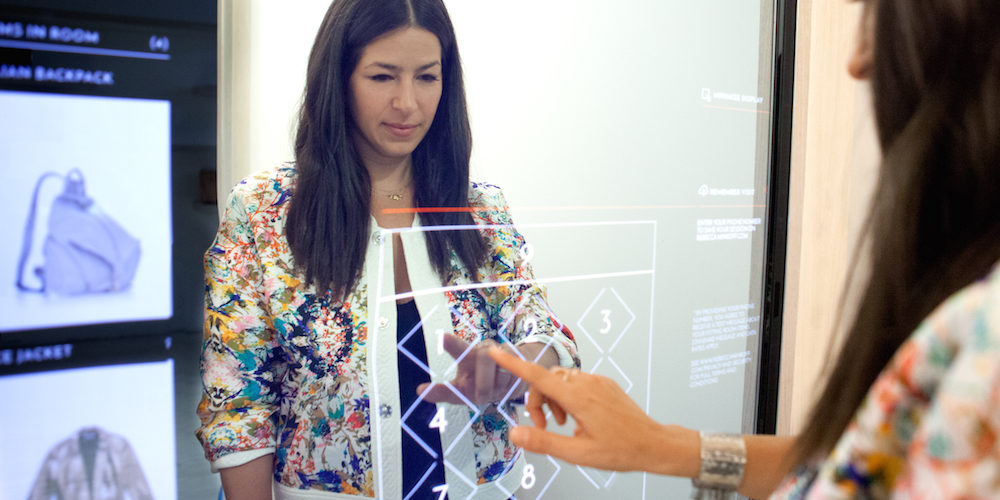اليوم, المستهلكون أكثر اطلاعا, تمكين وتطالب. كما الخط الفاصل بين العالمين المادي والرقمي يطمس, يجب أن تميز العلامات التجارية نفسها لدفع ولاء العملاء. وهذا يعني فرحة العملاء بما يفوق التوقعات في حين الحصول عليها السلع التي تريد شراء بسرعة.
مع كل الحديث عن المتاجر المتصلة والتكامل الرقمي, retailers may be a little confused as to where to start their search for digital adeptness. The good news is that it may not be as hard as they think through the use of وتتفاعل. RFID does two things—it allows you to manage your inventory so that you can get goods to customers faster and it also can pull consumer product intelligence in stores in order to bridge behavior. The two capabilities are powerful tools if used correctly—what’s more, they align to fundamental retail practices any brand understands today.
RFID Allows Retailers To Better Manage Their Inventory
According to Bill C. Hardgrave Ph.D., Dean and Wells Fargo Professor at Auburn University, 50 percent of the top 100 retailers are in the process of adopting RFID in order to better manage their inventory. Of those, 30 percent have proof of concept and 25 percent are rolling it out across their supply chain, building it into their manufacturing processes. Inventory accuracy, stock accuracy, loss protection and omni-channel enablement come from the use of RFID.
“There are four things a retailer needs in order to be able to omni-channel enabled,” said Hardgrave.
“Digital presence, physical presence, product visibility at the single unit level and the ability to ship from store are all pre-conditions high inventory accuracy. RFID becomes an enabler to omni-channel as it allows you address all these needs.”
RFID-tagging at item level enables retailers to tracking inventory more accurately while lowering staffing costs and increasing logistic efficiencies. Once moved to the store level, RFID can monitor all merchandise traffic through store, from delivery to the fitting room. It will show retailers what was brought in, how it was bought and with what it was paired with.
It’s a capability that Rebecca Minkoff has successfully leveraged in their stores.
RFID Allows Retailer to Blur the Lines Between Physical and Digital
According to Uri Minkoff, CEO at Rebecca Minkoff, RFID has revolutionized the way this cult brand has leveraged it to build seamless shopping experiences for it’s customers.
“We were one of the first brands in fashion to meet the consumer directly through social media,” said Minkoff. “As we developed our retail stores, we were committed to using digital technologies like RFID to engage with our consumer and get her the products she wanted when she visited our stores.”
According to Minkoff, the use of RFID not only allowed them to streamline their supply chain, but also develop a comprehensive analytic picture of their clients and also help their product designers understand what styles customers purchased most.
“Knowing which products she is bringing into the fitting room has enabled us to make better decisions about merchandising, and make better recommendations to all of our partners,” said Minkoff. “The analytics from our retail stores, coupled with the analytics from our best-in-class ecommerce site, have given us the confidence to move to a “see now, buy now” paradigm for our runway shows.” He went to share how RFID enabled their apparel sales, as a percentage of their total sales, to exceed initial projections by a factor of 3X due to their ability to put the right product in front of the customer while she is in the fitting room.
RFID Integrates to Retailer Practices Easily
Proven benefits of RFID technology—inventory accuracy and visibility, decreased out-of-stocks, and increased sales, increased NPS—are well documented. “Technology has drastically enhanced the consumer experience and RFID is at the forefront of this change,” notes Francisco Melo,Vice President, Global RFID at Avery Dennison.
“From item-level ability to smart mirrors, RFID has transformed the traditional brick-and-mortar storefronts into interactive digital spaces, seamlessly integrating technology that improves the retail experience for shoppers and retail associates.”
According to Melo, RFID integration is not a complicated process. Retailers looking to take advantage of it can integrate it into their supply chain fairly easily. So for brands looking to for technology that continues to build revenue, RFID is a simple start as return is well documented.
من: http://www.psfk.com/





